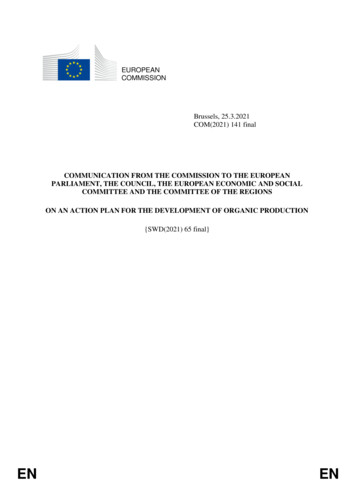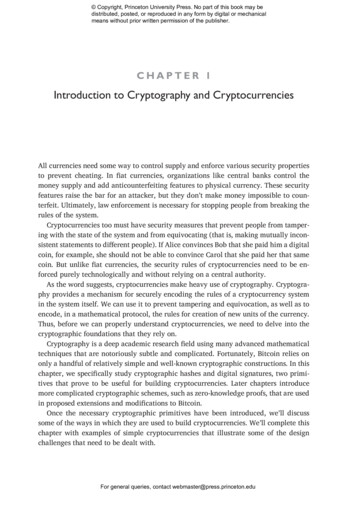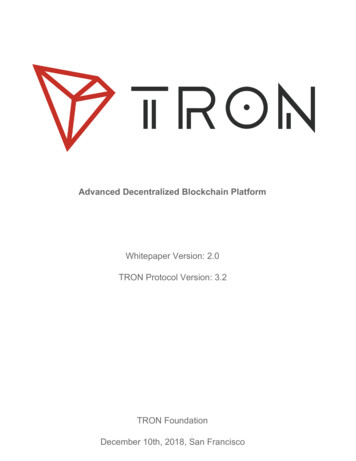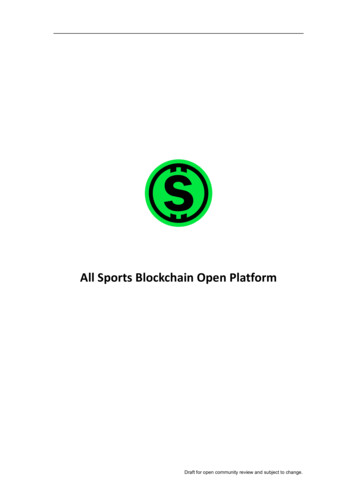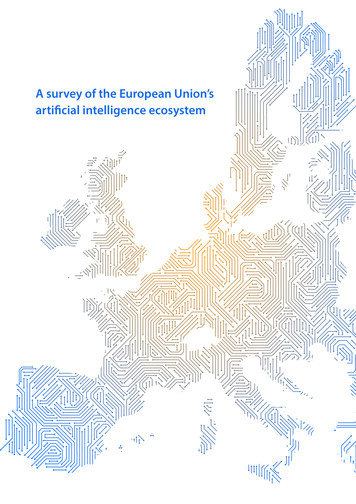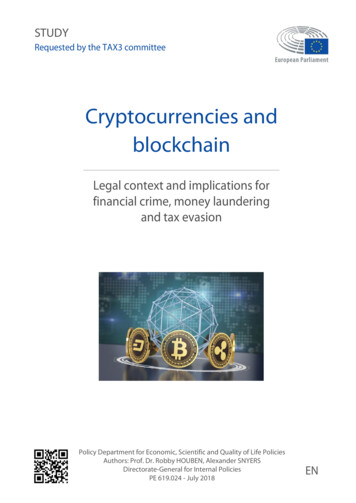
Transcription
STUDYRequested by the TAX3 committeeCryptocurrencies andblockchainLegal context and implications forfinancial crime, money launderingand tax evasionPolicy Department for Economic, Scientific and Quality of Life PoliciesAuthors: Prof. Dr. Robby HOUBEN, Alexander SNYERSDirectorate-General for Internal PoliciesPE 619.024 - July 2018EN
Cryptocurrencies andblockchainLegal context and implications forfinancial crime, money launderingand tax evasionAbstractMore and more regulators are worrying about criminals who areincreasingly using cryptocurrencies for illegitimate activities likemoney laundering, terrorist financing and tax evasion. Theproblem is significant: even though the full scale of misuse ofvirtual currencies is unknown, its market value has beenreported to exceed EUR 7 billion worldwide. This paperprepared by Policy Department A elaborates on thisphenomenon from a legal perspective, focusing on the use ofcryptocurrencies for financial crime, money laundering and taxevasion. It contains policy recommendations for future EUstandards.
This document was requested by the European Parliament's Special Committee on Financial Crimes,Tax Evasion and Tax Avoidance.AUTHORSProf. Dr. Robby HOUBEN, University of Antwerp, Research Group Business & Law, Belgium.Alexander SNYERS, University of Antwerp, Research Group Business & Law, Belgium.ADMINISTRATOR RESPONSIBLEDirk VERBEKENEDITORIAL ASSISTANTJanetta CUJKOVALINGUISTIC VERSIONSOriginal: ENABOUT THE EDITORPolicy departments provide in-house and external expertise to support EP committees and otherparliamentary bodies in shaping legislation and exercising democratic scrutiny over EU internalpolicies.To contact the Policy Department or to subscribe for updates, please write to:Policy Department for Economic, Scientific and Quality of Life PoliciesEuropean ParliamentB-1047 BrusselsEmail: Poldep-Economy-Science@ep.europa.euManuscript completed in June 2018 European Union, 2018This document is available on the internet esDISCLAIMER AND COPYRIGHTThe opinions expressed in this document are the sole responsibility of the authors and do notnecessarily represent the official position of the European Parliament.Reproduction and translation for non-commercial purposes are authorised, provided the source isacknowledged and the European Parliament is given prior notice and sent a copy. Cover image used under licence from Shutterstock.com
Cryptocurrencies and blockchainCONTENTSLIST OF ABBREVIATIONS6LIST OF BOXES8LIST OF FIGURES8LIST OF TABLES8EXECUTIVE SUMMARY9GENERAL INFORMATION111.1. Background111.2. Scope of the research121.3. Overview of policy recommendations for future EU standards14CRYPTOCURRENCIES AND BLOCKCHAIN152.1. What is blockchain?152.1.1. Defining blockchain: a technology with many faces152.1.2. How a blockchain works: the basics162.1.3. The blockchain consensus mechanisms182.1.4. Blockchain technology can have many applications192.2. What are cryptocurrencies?202.2.1. Introduction202.2.2. The policy makers: ECB, IMF, BIS, EBA, ESMA, World Bank and FATF202.2.3. Cryptocurrencies – Tokens – Cryptosecurities232.2.4. Cryptocurrencies – Blockchain242.3. Who are the players involved?242.3.1. Cryptocurrency users252.3.2. Miners252.3.3. Cryptocurrency exchanges262.3.4. Trading platforms272.3.5. Wallet providers272.3.6. Coin inventors282.3.7. Coin offerors28CLASSIFYING CRYPTOCURRENCIES293.1. Scoping the Crypto-Market293.2. Bitcoin and beyond: the 10 cryptocurrencies with the highest market capitalisation31PE 619.0243.2.1. Bitcoin (BTC)313.2.2. Ethereum (ETH)333
IPOL Policy Department for Economic, Scientific and Quality of Life Policies3.2.3. Ripple (XRP)353.2.4. Bitcoin Cash (BCH)363.2.5. Litecoin (LTC)373.2.6. Stellar (XLM)393.2.7. Cardano (ADA)403.2.8. IOTA (MIOTA)423.2.9. NEO (NEO)433.2.10. Monero (XMR)453.2.11. Dash (DASH)483.3. Conclusion: a taxonomy and timeline of cryptocurrencies49EU REGULATORY FRAMEWORK534.1. Setting the scene: similar regulatory challenges in the fight against money laundering,terrorist financing and tax evasion via cryptocurrencies534.1.1. Anonymity534.1.2. Cross-border nature544.1.3. Often no central intermediary544.1.4. Cryptocurrencies are falling between the cracks544.1.5. A difficult dividing line with cybersecurity, data protection and privacy554.1.6. Don’t throw the baby out with the bathwater: the technology564.1.7. The tide is changing: AMLD5574.2. Money laundering and terrorist financing584.2.1. Background584.2.2. AMLD4594.2.3. Cryptocurrencies under AMLD4624.2.4. The coming of age of the inclusion of cryptocurrencies into AMLD5624.2.5. Funds Transfer Regulation684.2.6. Cash Control Regulation694.3. Tax evasion70ADEQUACY OF THE REGULATORY FRAMEWORK735.1. Introduction735.2. Is the definition of virtual currencies under AMLD5 sufficient?735.2.1. Conclusions on the basis of the taxonomy735.2.2. Other virtual currencies than cryptocurrencies745.3. Is it enough to include only custodian wallet providers and virtual currency exchanges inthe list of obliged entities?765.3.1. State of play765.3.2. Users764PE 619.024
Cryptocurrencies and blockchain5.3.3. Miners765.3.4. Cryptocurrency exchanges775.3.5. Trading platforms775.3.6. Wallet providers785.3.7. Coin inventors785.3.8. Offerors785.3.9. The initial question795.4. Does the AMLD5 framework allow to pull enough cryptocurrency users into the light?795.5. Would it make sense to extend the scope of the Funds Transfer Regulation and/or theCash Control Regulation as to include cryptocurrency transactions?815.6. Is there a need for a more comprehensive approach, introducing license requirementsfor cryptocurrencies?815.7. Is it not best to introduce an outright ban for some aspects linked to somecryptocurrencies?825.8. Is the European level the appropriate one to tackle money laundering, terrorist financingand tax evasion via cryptocurrency transactions?83WHAT ABOUT BLOCKCHAIN?85REFERENCESPE 619.024865
IPOL Policy Department for Economic, Scientific and Quality of Life PoliciesLIST OF ABBREVIATIONSAMLD1First Anti-Money Laundering DirectiveAMLD2Second Anti-Money Laundering DirectiveAMLD3Third Anti-Money Laundering DirectiveAMLD4Fourth Anti-Money Laundering DirectiveAMLD5Fifth Anti-Money Laundering DirectiveBISBank for International SettlementsCPMICommittee on Payments and Market InfrastructuresDAC5Fifth revision of the Directive on administrative cooperation in taxationDLTDistributed ledger technologyEBAEuropean Banking AuthorityECBEuropean Central BankEIOPAEuropean Insurance and Occupational Pensions AuthorityESMAEuropean Securities and Markets AuthorityFATFFinancial Action Task ForceFIUFinancial intelligence unitFTRFunds Transfer RegulationIMFInternational Monetary FundITOInitial Token OfferingMTFMultilateral trading facilityOTFOrganised trading facilityP2PPeer to PeerPoSProof of Stake6PE 619.024
Cryptocurrencies and blockchainPoWProof of WorkPSD2Second revision of the Directive on Payment ServicesPE 619.0247
IPOL Policy Department for Economic, Scientific and Quality of Life PoliciesLIST OF BOXESBox 1:The Kovri-project48Box 2:The PrivateSend mixing-process explained49Box 3:Some thoughts on the TITANIUM project54LIST OF FIGURESFigure 1:How a blockchain works17Figure 2:Coin timeline52LIST OF TABLESTable 1:Overview of coins30Table 2:Coin taxonomy518PE 619.024
Cryptocurrencies and blockchainEXECUTIVE SUMMARYMore and more regulators are worrying about criminals who are increasingly using cryptocurrenciesfor illegitimate activities like money laundering, terrorist financing and tax evasion. The problem issignificant: even though the full scale of misuse of virtual currencies is unknown, its market value hasbeen reported to exceed EUR 7 billion worldwide. 1 This research elaborates on this phenomenon,focusing on the use of cryptocurrencies for financial crime, money laundering and tax evasion.The key issue that needs to be addressed is the anonymity surrounding cryptocurrencies. Thisanonymity, varying from complete anonymity to pseudo-anonymity, prevents cryptocurrencytransactions from being adequately monitored, allowing shady transactions to occur outside of theregulatory perimeter and criminal organisations to use cryptocurrencies to obtain easy access to"clean cash". Anonymity is also the major issue when it comes to tax evasion. When a tax authoritydoes not know who enters into the taxable transaction, because of the anonymity involved, it cannotdetect nor sanction this tax evasion.The existing European legal framework is failing to deal with this issue. There are simply no rulesunveiling the anonymity associated with cryptocurrencies. However, the tide is changing. The fifthrevision of the directive on money laundering and terrorist financing, AMLD5, is in the final phase ofbeing adopted. AMLD5 includes a definition of virtual currencies and subjects virtual currencyexchange services and custodian wallet providers to customer due diligence requirements and theduty to report suspicious transactions to financial intelligence units. The information obtained, canalso be used by tax authorities to combat tax evasion.AMLD5's definition of virtual currencies is sufficient to combat money laundering, terrorist financingand tax evasion via cryptocurrencies. Nevertheless, it is important to closely follow-up on the usecases of virtual currencies to ascertain that the definition remains to be a sufficient one goingforward.When we look at the key players in cryptocurrency markets, we can see that a number of those arenot included in AMLD5, leaving blind spots in the fight against money laundering, terrorist financingand tax evasion. The examples are numerous and include miners, pure cryptocurrency exchangesthat are not also custodian wallet providers, hardware and software wallet providers, tradingplatforms and coin offerors. Persons with malicious intent could look up these blind spots. If thatwould happen and it would appear to have a (material) adverse effect on the fight against moneylaundering, terrorist financing and tax evasion, expanding the scope of AMLD5 should be considered.With respect to unveiling the anonymity of users in general (i.e. also outside of the context of virtualcurrency exchanges and custodian wallet providers), no immediate action is taken. Only in its nextsupranational risk assessment, the Commission will assess a system of voluntary registration of users.This approach is not very convincing if the legislator is truly serious about unveiling the anonymity ofcryptocurrency users to make the combat against money laundering, terrorist financing and taxevasion more effective. A mandatory registration and a pre-set date as of which it applies, would be abetter approach, albeit of course more intrusive. For reasons of proportionality, mandatoryregistration could be made subject to a materiality threshold.1COMMISSION STAFF WORKING DOCUMENT IMPACT ASSESSMENT Accompanying the document “Proposal for a Directive of theEuropean Parliament and the Council amending Directive (EU) 2015/849 on the prevention of the use of the financial system for thepurposes of money laundering or terrorist financing and amending Directive 2009/101/EC”, SWD/2016/0223 final, ?uri CELEX:52016SC0223&from EN.PE 619.0249
IPOL Policy Department for Economic, Scientific and Quality of Life PoliciesFor some aspects relating to some cryptocurrencies a ban should be considered. To mind come thefeatures that are designed to make cryptocurrency users untraceable. Why is such degree ofanonymity truly necessary? Would allowing this not veer too far towards criminals? In any event,imposing a ban should always be focused on specific aspects facilitating the illicit use ofcryptocurrency too much.The European level is appropriate to address money laundering, terrorist financing and tax evasionvia cryptocurrencies. Even more appropriate is the international level, as crypto activity is not limitedby the European border. International collaboration is crucial to successfully impose and enforce ruleson combating money laundering, terrorist financing and tax evasion. From a regulatory perspective,the ongoing G20 attention paid to regulating cryptocurrencies is therefore welcome.As regards blockchain, it would be too blunt to associate blockchain with money laundering, terroristfinancing or tax evasion. It is just technology, on which a large number of cryptocurrencies run, butwhich is not designed to launder money, facilitate terrorist financing or evade taxes. Blockchain hasnumerous applications throughout the whole lawful economy. It would not be wise to discouragefuture innovations in this respect by submitting blockchain and fintech's exploring its use cases toburdensome requirements, simply because of one of the applications using blockchain technology,cryptocurrencies, is used illicitly by some. Therefore, blockchain should be left untouched from amoney laundering, terrorist financing and tax evasion perspective. The fight against moneylaundering, terrorist financing and tax evasion should focus on the illicit use cases ofcryptocurrencies.10PE 619.024
Cryptocurrencies and blockchainGENERAL INFORMATIONKEY FINDINGS The key issue that needs to be addressed in the fight against money laundering,terrorist financing and tax evasion via cryptocurrencies is the anonymitysurrounding cryptocurrencies. The existing European legal framework is failing to deal with this issue. The tide is changing: the fifth revision of the directive on money laundering andterrorist financing, AMLD5 includes a definition of virtual currencies and subjectsvirtual currency exchange services and custodian wallet providers to customer duediligence requirements and the duty to report suspicious transactions to financialintelligence units. A number of key players in cryptocurrency markets are not included in the scope ofAMLD5, leaving blind spots in the fight against money laundering, terroristfinancing and tax evasion. With respect to unveiling the anonymity of users in general, no immediate action istaken. The Commission will assess only in its next supranational risk assessment asystem of voluntary registration of users. A mandatory registration and a pre-setdate as of which it applies would be a better approach to unveil the anonymity ofcryptocurrency users. For some aspects relating to some cryptocurrencies a ban should be considered. The European level is appropriate to address money laundering, terrorist financingand tax evasion via cryptocurrencies, but even more more appropriate is theinternational level, as crypto activity is not limited by the European border. Blockchain is technology, on which a large number of cryptocurrencies run, butwhich is not designed to launder money, facilitate terrorist financing or evade taxes.Blockchain has numerous applications throughout the whole lawful economy. Thefight against money laundering, terrorist financing and tax evasion should focus onthe illicit use cases of cryptocurrencies and not on blockchain.1.1.BackgroundWith the growing popularity of the crypto market, the large number of unregulated cryptocurrencies(several hundreds), greater attention is now being paid by governments and other stakeholdersaround the world. Illustrative is that the total market capitalisation of the 100 largest cryptocurrenciesis reported to exceed the equivalent of EUR 330 billion globally by early 2018. The total marketcapitalisation of all cryptocurrencies together in that period peaked at an even higher USD 728billion, dropping just three weeks later to approximately USD 360 billion. 2 Regulators are looking atwhether — and how — to regulate cryptocurrencies. Up till now there is no univocal view on how todo that. In any event, there are compelling reasons why cryptocurrencies should be under more2R.M. BRATSPIES, "Cryptocurrencies and the Myth of the Trustless Transaction", March 2018, 6-7 (electronically available viahttps://ssrn.com/abstract 3141605).PE 619.02411
IPOL Policy Department for Economic, Scientific and Quality of Life Policiesscrutiny by regulators and supervisors. The threat of price volatility, speculative trading, hack attacks,money laundering and terrorist financing all call for stricter regulation.This research deep dives into the latter issue. According to many, aside from the instability ofcryptocurrency prices, these cryptocurrencies must have greater regulatory oversight in order toprevent illegal activity and illegitimate use. Aside from the instability of cryptocurrency prices,regulators are worrying about criminals who are increasingly using cryptocurrencies for activities(trading away from official channels) like fraud and manipulation, tax evasion, hacking, moneylaundering and funding for terrorist activities. The problem is a significant one: even though the fullscale of misuse of virtual currencies is unknown, its market value has been reported to exceed EUR 7billion worldwide. 31.2.Scope of the researchCryptocurrencies and blockchain are a monstrous topic. There are several hundreds ofcryptocurrencies and the applications of blockchain technology are also numerous. To make thisresearch a useful and focused one, we have to narrow it down. To do this, the research attaches tomultiple connecting factors, defining its scope.Firstly, the research is limited to cryptocurrencies and blockchain. This means that other types of assetsthan cryptocurrencies, such as tokens or crypto securities, are not within the scope of this research.We will explain how these assets differ from cryptocurrencies further on. We will also not elaborate onderivatives of cryptocurrencies, which are essentially investment instruments. Blockchain will bescrutinized to the extent cryptocurrencies run on this technology. Therefore, blockchain technologywill not be looked at outside of the context of cryptocurrencies, such as it being used as a techniqueto eliminate intermediaries in the financial, public or other sector. This would lead to far and exceedsthe scope of this research.Secondly, the research relates to the legal context of cryptocurrencies and blockchain. The focus is,hence, a legal one. This means that we will not elaborate on all the technical aspects – and there aremany – relating to cryptocurrencies and blockchain. We will only touch upon those to the extentnecessary to understand the legal context. We will also not take an economic, criminological or anyother approach than a legal one. We focus on the EU legal context. Therefore, we will not elaborateon the international 4 or national context, unless it is relevant to better understand the Europeancontext.Thirdly, the legal context is addressed in connection with the implications for financial crime, moneylaundering and tax evasion. Therefore, we will only scrutinize the legal context of cryptocurrenciesand blockchain to the extent relevant in connection with financial crime, money laundering and taxevasion. We will do this by assessing what exactly cryptocurrencies and blockchain are, whichchallenges they bring from the perspective of combating financial crime, money laundering and taxevasion, to which extent they are caught by legislation at European level and what could be done toimprove the legal framework. We will not deep dive into other legal queries than those related to34COMMISSION STAFF WORKING DOCUMENT IMPACT ASSESSMENT Accompanying the document “Proposal for a Directive of theEuropean Parliament and the Council amending Directive (EU) 2015/849 on the prevention of the use of the financial system for thepurposes of money laundering or terrorist financing and amending Directive 2009/101/EC”, SWD/2016/0223 final, ?uri CELEX:52016SC0223&from EN.See for a number of examples on non-EU measures on cryptocurrencies: T. KEATINGE, D. CARLISLE and F. KEEN, “Virtual currencies andterrorist financing: assessing the risks and evaluating responses”, study commissioned by the Directorate General for Internal Policies,Policy Department for Citizens’ Rights and Constitutional Affairs, May 2018, 47-50 (electronically available UD/2018/604970/IPOL STU(2018)604970 EN.pdf). See also: P. VALENTE, “Bitcoin andVirtual Currencies Are Real: Are Regulators Still Virtual?”, INTERTAX, Volume 46, Issue 6 & 7, 546-547.12PE 619.024
Cryptocurrencies and blockchainmoney laundering, terrorist financing and tax evasion, such as the qualification of cryptocurrenciesunder tax laws or the protection of investors in cryptocurrencies (whether or not consumers) underfinancial services laws. 5 Although very interesting, these queries exceed the scope of this research.Lastly, the research relates to financial crime, money laundering and tax evasion. Financial crime is noterm of art. Generally speaking, it is used as an umbrella term to designate all sorts of crimes relatingto the use of finances, such as fraud, theft, tax evasion, bribery, money laundering, terrorist financing,etc. In an EU context, financial crime includes inter alia crimes against the integrity of the financialsector, such as money laundering and insider dealing, and crimes against the financial interest of theUnion, such as fraud. In this research we will not elaborate on all imaginable financial crimes. On thecontrary, we will focus on money laundering, terrorist financing and tax evasion as subtypes offinancial crime. This focus can be justified for a number of reasons. Firstly, money laundering, terroristfinancing and tax evasion are at the forefront of the EU’s efforts on combating financial crime. 6Furthermore, the EU is clearly taking the approach to address cryptocurrency issues via anti-moneylaundering and counter terrorism financing legislation. This research acknowledges that approachand takes the same one. Secondly, leaving theft aside, money laundering, terrorist financing and taxevasion are probably the three types of financial crimes that are likely to be most associated withcryptocurrencies and blockchain, i.e. when persons commit a crime relating to cryptocurrencies andblockchain, the likelihood of that crime being money laundering, terrorist financing and/or taxevasion is high. Cryptocurrencies are thought to be very suitable for money laundering, terroristfinancing and tax evasion purposes because of their anonymity, cross-borders nature and quicktransferability 7. Thirdly, some crimes simply cannot be committed at this stage via cryptocurrencies.Financial crimes such as market abuse and insider dealing are for instance of no relevance forcryptocurrencies. Market abuse rules relate to financial instruments traded on a regulated market, amultilateral trading facility (“MTF”) or an organised trading facility (“OTF”). For the application tocryptocurrencies this poses two problems: cryptocurrencies are not financial instruments and theyare not traded on a regulated market, MTF or OTF.The research starts with a definition of cryptocurrencies and blockchain. After that, a taxonomy ofcryptocurrencies will be given on the basis of an analysis of the 10 cryptocurrencies with the highestmarket capitalisation. This taxonomy will serve as a benchmark throughout this research and willallow to verify the adequacy of the existing and upcoming legal framework.This study has been completed on 20 June 2018.567Another interesting query, which we will also not deep dive into in the context of this study, is how cryptocurrencies affect monetarypolicy. For more information on this topic we refer to: D. HELLER, “The implications of digital currencies for monetary policy”, in-depthanalysis commissioned by the Directorate General for Internal Policies, Policy Department A: Economic and Scientific Policy, May 2017,12p. (electronically available AN/2017/602048/IPOL IDA(2017)602048 EN.pdf).See e.g. E. HERLIN-KARNELL and N. RYDER, “The robustness of EU Financial Crimes Legislation: A Critical review of the EU and UK Anti-Fraudand Money Laundering Scheme”, 2017, European Business Law Review, No. 4, 1-39.See e.g. S. ROYER, “Bitcoins in het Belgische strafrecht en strafprocesrecht”, RW 2016-17, No. 13, 486.PE 619.02413
IPOL Policy Department for Economic, Scientific and Quality of Life Policies1.3.Overview of policy recommendations for future EU standardsThis study sets out a number of policy recommendations for future EU standards. The main ones areoutlined below.Policy recommendations for future EU standards To unveil the anonymity of cryptocurrency users the EU should consider a system ofmandatory registration of users and a pre-set date as of which it applies rather than a systemof voluntary registration of users. The EU should also think about expanding the list of “obliged entities” under AMLD5 withthose players that are identified in this study as the weak spots or have great potential ofbeing weak spots, including miners, pure cryptocurrency exchanges that are not alsocustodian wallet providers, software and hardware wallet providers, trading platforms andcoin offerors. Furthermore, the EU should think about imposing a specific ban on such aspects surroundingcryptocurrencies that are aimed at making it impossible to verify their users (e.g. mixing) andcriminally sanctioning these aspects. In addition, the EU could consider extending the scope of the Funds Transfer Regulation tomake sure that all relevant information accompanying cryptocurrency transactions is there,allowing an adequate money laundering and terrorist financing check. The entities thatwould have to fulfil the requirements could be the intermediaries through which thetransactions run. In the longer term, the EU should consider developing a tailored and more comprehensiveframework for cryptocurrencies, and setting EU standards for cryptocurrencies in line withsuggestions and recommendations made by the EBA, including license requirements forcryptocurrency service providers. Part of such framework could be to create or impose a“middleman”, where the use of blockchain or other distributed ledger technology has cut outsuch middleman, as this will allow the regulator to attach regulation to an identifiable person,thus contributing to enhanced compliance and effective enforcement. With a view of achieving unified regulation of cryptocurrencies at G20 level, it isrecommended that the EU leads further initiatives by example. The EU should leave blockchain be from a money laundering, terrorist financing and taxevasion perspective and focus on the illicit use cases of cryptocurrencies. Blockchain is justtechnology and can have beneficial effects in a wide array of sectors. Its development as suchshould not be discouraged.14PE 619.024
Cryptocurrencies and blockchainCRYPTOCURRENCIES AND BLOCKCHAIN2.1.What is blockchain?2.1.1.Defining blockchain: a technology with many facesBlockchain is a particular type or subset of so-called distributed ledger technology (“DLT”). 8 DLT is away of recording and sharing data across multiple data stores (also known as ledgers), which eachhave the exact same data records and are collectively maintained and controlled by a distributednetwork of computer servers, which are called nodes. 9Blockchain is a mechanism that employs an encryption method known as cryptography 10 and uses (aset of) specific mathematical algorithms to create and verify a continuously growing data structure –to which data can only be added and from which existing data cannot be removed – that takes theform of a chain of “transaction blocks” 11, which functions as a distributed ledger. 12In practice, blockchain is a technology with many “faces”. It can exhibit different features and covers awide array of systems that range from being fully open and permissionless, to permissioned 13: On an open, permissionless blockchain, a person can join or leave the network at will, withouthaving to be (pre-)approved by any (central) entity. 14 All that is needed to join the network andadd transactions to the ledger is a computer on which the relevant software has been installed.There is no central owner of the network and software, and identical copies of the ledger aredistributed to all the nodes in the network. 15 The vast majority of cryptocurrencies currently incirculation is based on permissionless blockchains (e.g. Bitcoin, Bitcoin Cash, Litecoin, ). On a permissioned blockchain, transaction validators (i.e. nodes) have to be pre-selected by anetwork administrator (who sets the rules for the ledger) to be able to join the network. 16 Thisallows, amongst others, to easily verify the identity of the network participants. 17 However, at thesame time it also requires network participants to put trust in a central coordinating entity to891011121314151617Another example of distributed ledger technology is “directed acyclic graph”, the underlying technology of the IOTA-platform (seebelow). See also: M. VAN DE LOOVERBOSCH, “Crypto-effecten: tussen droom en daad”, TRV-RPS 2018, 193, footnote 2.See: World Bank Group (H. NATARAJAN, S. KRAUSE, and H. GRADSTEIN), “Distributed Ledger Technology (DLT) and blockchain”, 2017, FinTechnote, no. 1. Washington, D.C., s://www.bis.org/cpmi/publ/d137.pdf, 5.This technique is discussed and defined further below.Hence the name “blockchain”.See: World Bank Group (H. NATARAJAN, S. KRAUSE and H. GRADSTEIN), “Distributed Ledger Technology (DLT) and blockchain”, 2017, FinTechnote, no. 1. Washington, D.C., Technology-and-Blockchain-Fintech-Notes.pdf, 1.Some autho
Cryptocurrencies and blockchain PE 619.024 5 . 5.3.3. Miners 76 5.3.4. Cryptocurrency exchanges
